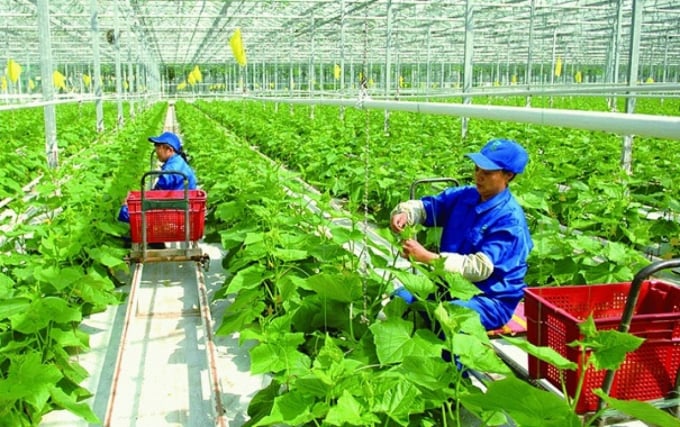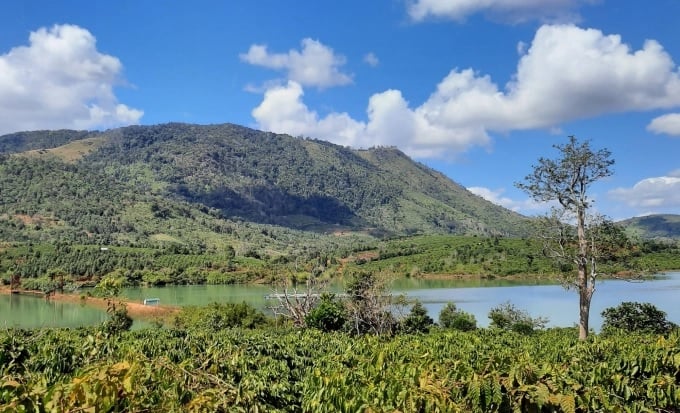November 28, 2025 | 01:02 GMT +7
November 28, 2025 | 01:02 GMT +7
Hotline: 0913.378.918
November 28, 2025 | 01:02 GMT +7
Hotline: 0913.378.918

Workers caring vegetables in nethouse.
Today's food and agriculture systems have succeeded in supplying large quantities of food to the global market. However, most of the systems require a lot of external input and use a lot of resources. This has caused deforestation, water scarcity, biodiversity loss, land depletion and greenhouse gas emissions.
As part of the global response to climate instability, agroecology is regarded as a unique approach to meeting large increases in food demand in the future.
Proposed in scientific documents since the 1920s, agroecology is now divided into 10 elements: Diversity, Co-creation and sharing of knowledge, Synergies, Efficiency, Recycling, Resilience, Human and social values, Culture and food traditions, Responsible governance, Circular and solidarity economy.
Different from some other approaches to sustainable development, agroecology focuses on bottom-up and territorial procedures, with an emphasis on providing contextual solutions to local issues. The innovation of agroecology is based on the co-creation of knowledge, combining science with traditional knowledge and local practices.
According to Dr. Dao The Anh, Deputy Director of the Vietnam Academy of Agricultural Sciences (VAAS), in the 10 factors mentioned above, diversity is the key to agroecology transition.
From the biology perspective, agroecology systems optimize species diversity and genetic resources. For example, agroforestry systems organize shrubs and large trees of different heights and shapes in overlapping levels or strata, which increases diversity in breadth. In agroproduction, the main methods to increase diversity include intercropping and rotation. In animal husbandry and aquaculture, diversity is also applied in models such as combining many types of ruminants to help reduce health risks caused by parasites. "Agriculture will thrive in terms of efficiency on the basis of promoting diversity and other factors.”
Vietnam currently has six developing agroecology groups, including: agroforestry, integrated plant health management (IPHM), improved rice intensification systems, and husbandry/aquaculture multi-systems, organic farming, and landscape conservation agriculture.

Dak Krong commune has rich natural scenery, suitable for the coffee landscape model.
The Central Highlands initiates many agroforestry models that are associated with forest protection, adaptation to climate change, and soil erosion control. Some highlight models include the cattle raising model under forest canopy, coffee - fruit trees intercropping, coffee - black beans intercropping, and forest protection farms.
Research of the Sustainable Trade Initiative (IDH) shows that coffee monoculture farms are a net carbon emissions source. To produce 1 ton of coffee, the amount of carbon dioxide released into the air can reach up to 0.37 tons/year on average. As a world leading coffee exporter, Vietnam also needs to pay more attention to this issue.
In search of improvement, IDH sponsors several projects in Dak Lak and Lam Dong through the Initiative for Sustainable Landscapes (ISLA). Thanks to these projects, farms now grow coffee in a polyculture method which helps to eliminate 0.16 tons of carbon dioxide from the atmosphere every year for every ton of coffee harvested by generating more biomass thus isolating more carbon dioxide than the amount emitted during production.
Through a two-year study from 300 coffee farms, IDH recommends farmers use a polyculture model. The dispersion density between coffee and other crops should be a 70 - 30 ratio. This helps maintain annual coffee production at 3 tons/ha. Pepper, durian and avocado are the most suitable for intercropping at this density.

Ms. Tran Quynh Chi, IDH Asia Regional Director, believes that farmers should use a polyculture model to reach higher efficiency in coffee growing.
Ms. Tran Quynh Chi, IDH Asia Regional Director, said, “Along with the positive impacts on the environment, farmers can acquire an additional source of income from a number of suitable crops. This is also IDH’s standpoint in the agroecology landscape approach which groups all producers, stakeholders, owners and land users in one geographical area.”
Another positive point when making a transition to agroecology systems is that many coffee farms in the Central Highlands at present become a source of carbon revenue, contrary to its previous impression of a source of emissions. Ms. Chi shared that among highly diversified farms, 73% have negative carbon emissions rate (absorb > emit) and only 27% have positive emissions. The situation is the complete opposite in the case of monoculture farms when 70% of farms act as carbon emitters.
Translated by Samuel Pham

(VAN) According to Mr. Vo Minh Thanh, Director of the Tay Ninh Department of Agriculture and Environment, Resolution 57 has created a new development pathway for the locality, shifting from traditional toward modern agriculture.
/2025/11/26/4909-2-154329_878.jpg)
(VAN) Pearl grouper farming in HDPE cages not only delivers economic efficiency but also contributes to protecting the environment, creating jobs, and promoting marine-based experiential tourism.

(VAN) The model of making a living under the forest canopy through the agroforestry system in Van Son commune, Bac Ninh province, is expected to generate an annual income of approximately VND 30 million/ha.

(VAN) Many enterprises in Can Tho are harnessing natural energy and reducing greenhouse gas emissions in their production processes, thereby contributing to the promotion of a sustainable green transition.
/2025/11/24/3536-2-112800_176.jpg)
(VAN) Dong Nai now has tens of thousands of hectares of forests certified for sustainable management, and this area will continue to be expanded in the coming period.

(VAN) Vinh Ha hamlet (Dai Xuyen commune, Hanoi) is shifting away from small-scale farming as households adopt bioscurity into their breeder chicken models.

(VAN) Heavy rains make aquatic species more vulnerable to disease. Proactive water management and high-tech systems help farmers prevent outbreaks and protect yields.